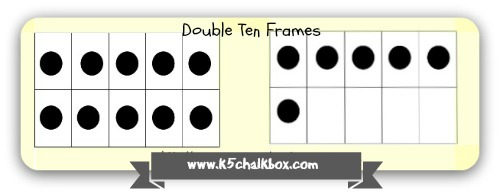Ten frames encourage students to move beyond counting and develop spatial abilities in number sense.
Watch your students add simple digits. How many of them still use their fingers? Then ask them how many ways there are to make a number, such as 8. Can they tell you all of the ways?
Many students do not have a conceptual understanding of what a number really consists of – they visualize a number as only a digit. This type of visualization makes it impossible for a child to break apart a number into two parts, such as 6 and 4 or 3 and 7.
Ten frame activities help our minds to organize numbers into workable “chunks” of 5 and 10 that match our number system of Base Ten. A rectangle is divided into two rows of 5 columns each (a grid) that can then be filled with dots, markers, or left blank.
Subitizing, Composing and Decomposing of Numbers
Subitizing
We all have the ability to subitize (the instant recognition of how many objects are in a group). But some children have not developed this into a workable strategy.
Think about it: when you play a math game using dice, you instantly recognize the numbers by their placement within a group. You do the same with dominoes. But how many children in your classroom have regularly played with these objects?
A ten frame makes it easy to see the organization of numbers: 5 dots in one row and 3 in another makes 8.
Composing and Decomposing
For students to develop a strong number sense in Base Ten, they have to understand not only how numbers are formed (composing) but also how to break them down (decomposing). Without the innate ability to decompose, kids will have a very difficult time with addition and subtraction strategies.
Example: Think about the equation 8 + 6. If a child can quickly think that taking 2 from the 6 will make 10 (8 + 2) and leave 4, then this is a much easier Base Ten equation: 10 + 4.
Using ten frames will allow the children to manipulate the numbers into more workable equations that make sense to them.
Introducing Ten Frames
Single Ten Frame
Begin by showing groups of dots randomly applied to cards. Talk about how difficult it is to see how many dots there are on each card, and tell them you have an easier way to look at groups of dots.
Put a blank Ten Frame on your Smartboard or overhead. Discuss how many spaces they see and how the frame is arranged.
Move some chips (always keep to the same color) onto the Ten Frame. Talk about the patterns they see, how the chips are arranged, how many chips there are altogether, and how many blank spaces are left.
Later, have some ten frame cards ready to use as a quick activity with the students. I have a stack of them that I flash in front of them and they call out the number shown by the dots. I then switch it up by asking how many blanks are shown.
Double Ten Frames
After the students are experiencing consistent success with identifying numbers on a single ten frame, I introduce Double Ten Frames.
Use the same routine for introducing single ten frames. The key to this is to show the numbers exactly like we write them in Base Ten, with a full frame on the left and the partial frame on the right. For example, the number 16 as shown below as 10 + 6, 4 less than 20, or 3 groups of 5 plus 1.
Number Sense Games Using Ten Frames
1. War
Played exactly like the traditional card game of War. The ten frame cards are dealt into two piles and players flip the cards at the same time. Whoever has more wins the cards. To differentiate, whomever has less wins.
2. Which Is Not Like the Others?
Hold up 3 ten frame cards, two that show the same number and one that does not. The goal is for students to instantly recognize the number that is not the same as well as the patterns of the two numbers that are the same and be able to verbalize how they are alike.
3. Race to 100
You need a 100s chart, one dice, two counters (1 per player) and a ten frame with 10 counters.
The first player rolls the dice. Whatever it takes to make a 10 is how many spaces the player moves. i.e. Roll a 6, so the player moves 4. Roll a 3 and the player moves 7. The first one to 100 wins.
Where does the Ten Frame come in? Many children cannot conceptualize how many more it will take to make 10, so when the dice is rolled, they can move the counters onto the Ten Frame then count the remaining spaces to see how much they move. After doing this a while, most kids will naturally start to move away from needing the ten frame as their conceptual understanding of what makes 10 increases.
Differentiate this game by using 2 dice and having the students make 20 instead of 10.
4. More or Less
Flash a Ten Frame card in front of the students. Then say:
- “One more?”
- “One less?”
- “Ten more?”
- “Ten less?”
- “How many more to 10?”
- “How many more to 20?”
- “How many less than 10?”
- “How many less than 20?”
Differentiate this game by asking students if the number is even or odd, multiply the number by 2, 5 or 10, or asking how many more to 100.
